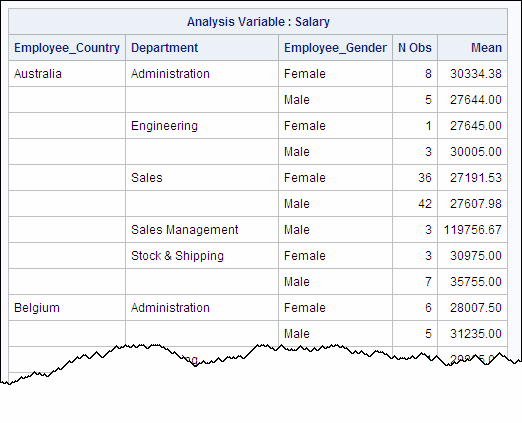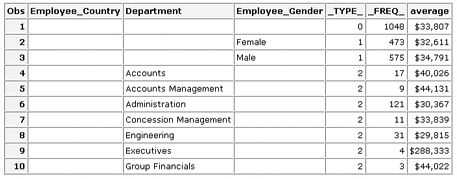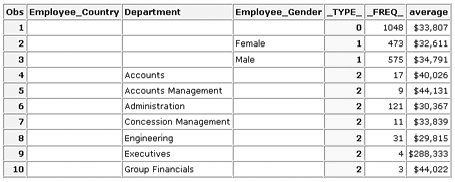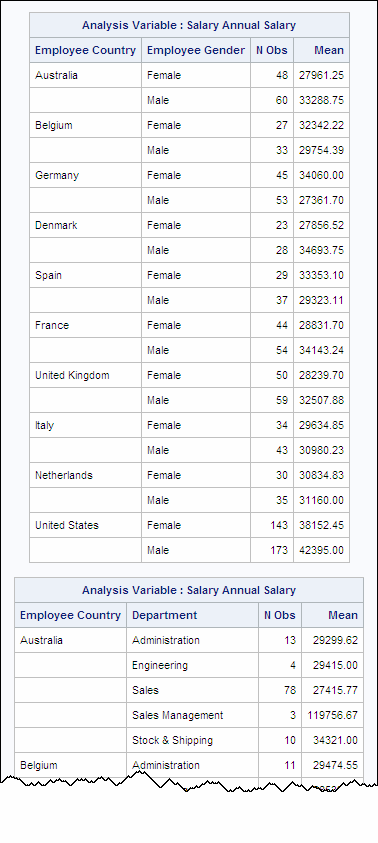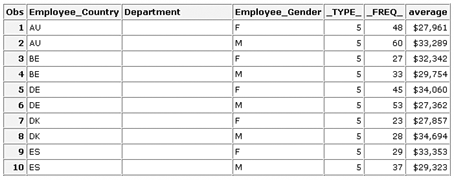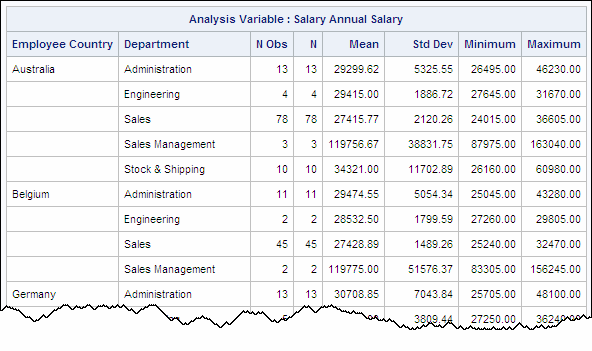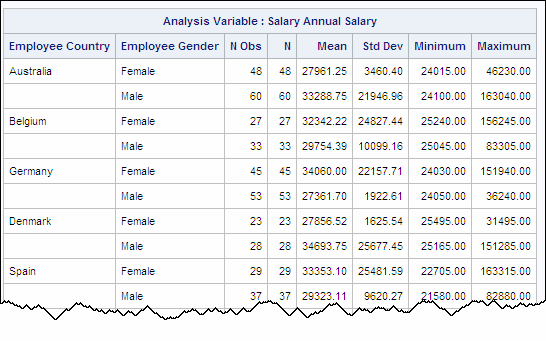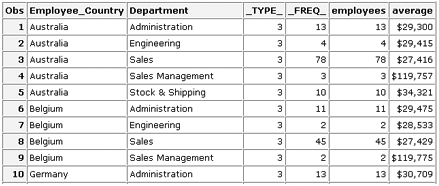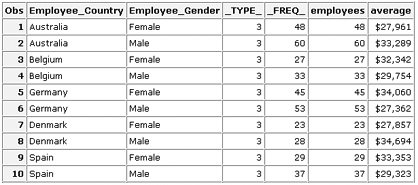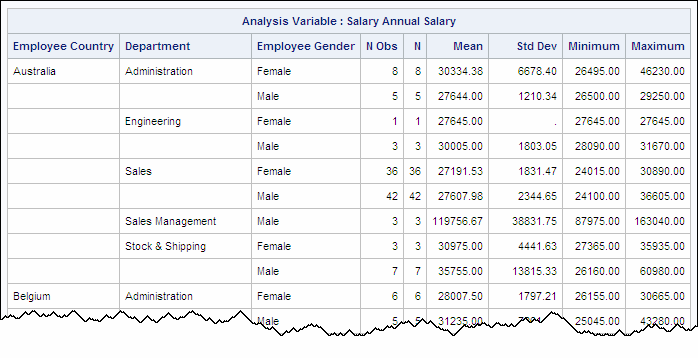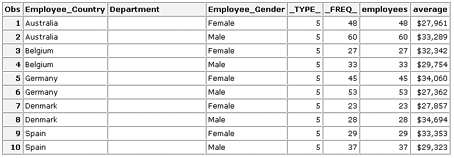Comparing Tools for Summarizing Data
Overview
SAS provides a variety of tools for
summarizing data. These summarization tools generate similar but not
identical output, and they vary in efficiency.
Note: Throughout this section,
all references to the MEANS procedure apply also to the SUMMARY procedure.
|
Tool
|
Description
|
|---|---|
|
MEANS procedure or SUMMARY
procedure
|
|
|
TABULATE procedure
|
|
|
REPORT procedure
|
|
|
SQL procedure
|
|
|
DATA step
|
|
Note: You
can also use the FREQ and UNIVARIATE procedures to generate summary
data reports, but these procedures are not covered in this chapter.
For more information about any of these summarization tools, see the
SAS documentation for PROC FREQ and PROC UNIVARIATE in the Base SAS Procedures Guide.
Any of these tools can
summarize the entire data set or by any combination of one or more
class variables.
To group data, PROC
MEANS, PROC SUMMARY, and PROC TABULATE use a CLASS statement. PROC
SQL uses a GROUP BY clause. Every tool except PROC SQL accepts a BY
statement.
Comparing Resource Usage across Summarization Tools
When
summarizing data for one or more class variables, the tools in each
of the following groups are similar in resource usage:
-
PROC MEANS (or PROC SUMMARY), PROC REPORT, and PROC TABULATE
-
PROC SQL and the DATA step with PROC SORT
However, the relative
efficiency of the two groups of tools can vary based on the number
of values of the CLASS variables. You need to test the techniques
with your data.
Comparative Example: Displaying Summary Statistics for One Class Variable
Overview
Suppose
you want to summarize the data set Retail.Orders by calculating the
average quantity of products sold for each value of the class variable
Order_Type. You can use several techniques to produce the summary
report.
The following programs
compare five techniques. You can use these samples as models for creating
benchmark programs in your own environment. Your results might vary
depending on the structure of your data, your operating environment,
and the resources that are available at your site.
Programming Techniques
|
This PROC MEANS step
creates a report that displays the mean of the analysis variable Quantity
for each value of the class variable Order_Type.
proc means data=retail.orders
(keep=order_type quantity)
mean maxdec=2;
class order_type;
var quantity;
run; |
|
This
PROC REPORT step creates a report that displays the mean of the analysis
variable Quantity for each value of the class variable Order_Type.
proc report data=retail.orders
(keep=order_type quantity);
column order_type quantity;
define order_type / group width=13
'Order Type';
define quantity / mean format=5.2
'Average Quantity'
width=8;
run; |
|
This
program uses a PROC SORT step and a DATA step to create a report.
The PROC SORT step sorts the data by the values of the variable Order_Type,
keeps only the necessary variables, and generates the temporary output
data set Orders. The DATA step calculates the mean of the analysis
variable Quantity for each value of the BY variable Order_Type and
displays these values in a report.
proc sort data=retail.orders
(keep=order_type quantity)
out=orders;
by order_type;
run;
data _null_;
set orders;
by order_type;
format average_order 5.2;
if first.order_type then do;
num=0;
sum=0;
end;
num+1;
sum+quantity;
if last.order_type then do;
average_order=sum / num;
file print;
put @5 'Order Type' @20 'Average Order';
put;
put @13 Order_type 1. @27 Average_order 5.2;
end;
run; |
|
This
PROC SQL step creates a report that displays the mean of the analysis
variable Quantity for each value of the group variable Order_Type.
proc sql;
select order_type,
avg(quantity) label='Average Order'
format=5.2
from retail.orders
group by order_type;
quit; |
|
This
PROC TABULATE step creates a report that displays the mean of the
analysis variable Quantity for each value of the class variable Order_Type.
proc tabulate data=retail.orders
(keep=order_type quantity)
format=comma8.2;
class order_type;
var quantity;
table order_type, quantity*mean;
run; |
Using PROC MEANS to Display Summary Statistics for Combinations of Class Variables
To produce summary statistics
for combinations of class variables, you can use PROC MEANS in the
following ways. These techniques differ in resource usage.
|
Combinations of Class
Variables
|
Technique
|
Example
|
|---|---|---|
|
all possible combinations:
a
b
c
a
* b
a
* c
b
* c
a
* b * c
|
basic PROC MEANS step
|
proc means data=lib.dataset mean;
class a b c;
var salary;
output out=summary1
mean=average;
run; |
|
specific combinations:
a
* b and a * c
|
TYPES statement in PROC
MEANS
|
proc means data=lib.dataset mean; class a b c; var salary; types a*b a*c; output out=summary2 mean=average; run; |
|
specific combinations:
a
* b and a * c
|
NWAY option in multiple
PROC MEANS steps
|
proc means data=lib.dataset nway; class a b; var salary; output out=summary3a mean=average; run; proc means data=lib.dataset nway; class a c; var salary; output out=summary3b mean=average; run; |
|
specific combinations:
a
* b and a * c
|
WHERE= option in the
OUTPUT statement in PROC MEANS
|
proc means data=lib.dataset; class a b c; var salary; output out=summary4 (where=(_type_ in (5,3))) n=employees mean=average; run; |
Comparing Resource Usage across Three Techniques for Using PROC MEANS
The three techniques for summarizing
data for specific combinations of class variables (all but the basic
PROC MEANS step) differ in resource usage as follows:
-
The TYPES statement in a PROC MEANS step uses the fewest resources.
-
A program that contains the NWAY option in multiple PROC MEANS steps uses the most resources because SAS must read the data set separately for each PROC MEANS step. The NWAY option in a single PROC MEANS step is efficient.
-
The WHERE= data set option in a PROC MEANS step uses more resources than the TYPES statement in PROC MEANS because SAS must calculate all possible combinations of class variables before subsetting. However, the WHERE= data set option in PROC MEANS uses fewer resources than the NWAY option in multiple PROC MEANS steps.
We learn how to use
a basic PROC MEANS step and the three other techniques that are listed
above.
Using a Basic PROC MEANS Step to Combine All Class Variables
PROC MEANS (or PROC SUMMARY)
creates the following:
-
An output report that groups data and displays summary statistics for the combination of all class variables. This is the default action.
-
If an OUTPUT statement appears, PROC MEANS creates an output data set with summary statistics for all possible combinations of the n class variables (from 1-way to n-way), as well as for the entire data set
Example: Displaying Summary Statistics for All Combinations of the Class Variables
Suppose
you want to calculate average employee salaries and group results
for the combination of the three class variables Employee_Country,
Department, and Employee_Gender.
The following PROC MEANS
program creates both a report data set and a SAS data set:
proc means data=company.organization_dim mean; class employee_country department employee_gender; var salary; output out=summary mean=average; run;
The
report displays summary statistics for every combination of the three
class variables. A partial report is shown below:
The
output data set contains summary statistics for the following:
-
all possible combinations (1-way, 2-way, and 3-way) of the three class variables:
-
Employee_Gender
-
Department
-
Employee_Country
-
Department and Employee_Gender
-
Employee_Country and Employee_Gender
-
Employee_Country and Department
-
Employee_Country and Department and Employee_Gender
-
-
the entire data set
A partial view of the
output data set is shown below:
Understanding Types
Each combination
of class variables that is used to calculate and group statistics
for PROC MEANS is called a type.
For example, the following
basic PROC MEANS step specifies the three class variables a, b, and
c:
proc means data=lib.dataset mean;
class a b c;
var salary;
output out=summary1
mean=average;
run;This PROC MEANS step
generates seven possible types (combinations of the three variables):
|
Variable Combined
|
Dimension
|
|---|---|
|
a
|
1-way
|
|
b
|
1-way
|
|
c
|
1-way
|
|
b * c
|
2-way
|
|
a * b
|
2-way
|
|
a * c
|
2-way
|
|
a * b * c
|
3-way
|
The
_TYPE_ variable has a unique value for each combination of class variables,
based on their order in the CLASS statement. For example, for each
of the seven types (seven possible combinations of three class variables)
shown above, SAS assigns a value to _TYPE_ as follows:
_TYPE_ Value
|
Description of Combination
|
Variables Combined
|
Dimension
|
|---|---|---|---|
|
1
|
rightmost variable only
|
c |
1-way
|
|
2
|
b |
1-way
|
|
|
3
|
rightmost variable and
middle variable
|
b * c |
2-way
|
|
4
|
leftmost variable
|
a |
1-way
|
|
5
|
leftmost variable and
rightmost variable
|
a * c |
2-way
|
|
6
|
leftmost variable and
middle variable
|
a * b |
2-way
|
|
7
|
rightmost variable and
middle variable and leftmost variable
|
a * b * c |
3-way
|
As the number of class
variables increases, so does the number of types. However, the highest
_TYPE_ (7, in this example) always indicates the combination of all
class variables.
SAS includes the _TYPE_
variable in the output data set generated by PROC MEANS. Observations
are generated in order of increasing values of the _TYPE_ variable:
The
first observation in the output data set has a _TYPE_ value of 0,
which indicates that the statistics are generated for the entire data
set.
By default, the output
data set generated by PROC MEANS contains a separate observation for
each unique combination of class variable values within each type.
Each unique combination of values within a type is called a level
of that type. In the output data set linked above, there are 17 levels
for type 2. Therefore, 17 observations have a _TYPE_ value of 2.
The report generated
by PROC MEANS contains only the combinations of all class variables,
_TYPE_=7. _TYPE_ is not displayed in the report.
Using the TYPES Statement in PROC MEANS to Combine Class Variables
The
TYPES statement specifies the desired combinations of class variables.
The CLASS statement is required with the TYPES statement.
|
General form, TYPES
statement:
TYPES request(s);
request(s)
specifies the desired
combination or combinations of class variables. A request includes
one of the following:
|
To request combinations
of class variables more concisely, you can use a grouping syntax by
placing parentheses around several variables and joining other variables
or variable combinations. The following examples of TYPES statements
illustrate the use of grouping syntax:
Example: Using the TYPES Statement in PROC MEANS
Suppose
you want to calculate average employee salaries, as in the previous
example. This time, you want the two combinations of class variables
shown below:
-
Employee_Country and Department
-
Employee_Country and Employee_Gender
To do this, you can
add a TYPES statement to the PROC MEANS step:
proc means data=company.organization_dim mean;
class employee_country department
employee_gender;
var salary;
types employee_country*department
employee_country*employee_gender;
output out=summary mean=average;
run;This
PROC MEANS step generates both a report data set and an output data
set. The report, shown below, has a separate table for each of the
two combinations specified in the TYPES statement:
The
output data set includes only the combinations that are specified
in the TYPES statement. A partial view of the output data set is shown
below:
Using the NWAY Option in PROC MEANS to Combine Class Variables
Another way to specify a combination of class variables
is to use the NWAY option in PROC MEANS:
|
General form, NWAY option
in the PROC MEANS statement:
PROC MEANS NWAY;
NWAY
specifies
that the output data set contains statistics for the combination of
all specified class variables (only observations with the highest
_TYPE_ value).
|
The
NWAY option generates summary statistics for every combination of
all class variables. Therefore, to generate statistics for different
combinations of class variables, you can specify a separate PROC MEANS
step with the NWAY option for each combination.
Example: Using the NWAY Option in Multiple PROC MEANS Steps
Suppose you want to
calculate average employee salaries and to group results for the following
combinations of class variables:
-
Employee_Country and Department
-
Employee_Country and Employee_Gender
You
can use two PROC MEANS steps, each containing the NWAY option, as
shown below. The first PROC MEANS step generates statistics for the
first combination of class variables, and the second PROC MEANS step
generates statistics for the second combination of class variables.
proc means data=company.organization_dim nway; class employee_country department; var salary; output out=summary1 n=employees mean=average; run; proc means data=company.organization_dim nway; class employee_country employee_gender; var salary; output out=summary2 n=employees mean=average; run;
When
processing this program, SAS must read the data set once for each
PROC MEANS step. This processing is not efficient.
This program generates
two reports and two output data sets. The report, shown in part below,
has a separate table for each PROC MEANS step:
A partial view of each
output data set is shown below:
Using the WHERE= Output Data Set Option in PROC MEANS to Select Desired Types
Yet
another way to select desired types is to use the WHERE= output data
set option in the OUTPUT statement:
|
General form, WHERE=
output data set option in a basic OUTPUT statement:
OUTPUT <OUT=SAS-data-set> (WHERE=
(where-expression-1 <logical-operator
where-expression-n>));
SAS-data-set
specifies the output
data set as a 1-level or 2-level name.
where-expression
is an arithmetic or
logical expression that consists of a sequence of operators, operands,
and SAS functions. The expression must be enclosed in parentheses.
logical-operator
can be AND, AND NOT,
OR, or OR NOT.
|
When
you use the WHERE= output data set option in the OUTPUT statement,
SAS must calculate all possible combinations of class variables. Subsetting
does not occur until the results are written to the output data set.
Example: Using the WHERE= Output Data Set Option in PROC MEANS
Suppose
you want to calculate average employee salaries and select results
for two 2-way combinations of the three class variables Employee_Country,
Department, and Employee_Gender. All possible combinations of these
variables are listed below:
_TYPE_ Value
|
Variables Combined
|
Dimension
|
|---|---|---|
|
1
|
Employee_Gender
|
1-way
|
|
2
|
Department
|
1-way
|
|
3
|
Department * Employee_Gender
|
2-way
|
|
4
|
Employee_Country
|
1-way
|
5 |
Employee_Country * Employee_Gender
|
2-way |
6 |
Employee_Country * Department
|
2-way |
7 |
Employee_Country * Department
* Employee_Gender
|
3-way |
To specify the types
by _TYPE_ value, you can use the WHERE= output data set option in
the OUTPUT statement as shown below:
proc means data=company.organization_dim;
class employee_country department
employee_gender;
var salary;
output out=summary
(where=(_type_ in (5,6)))
n=employees
mean=average;
run;A
partial view of the report is shown below. The PROC MEANS report represents
the highest type, the NWAY combination, type 7, which was not requested.
A
partial view of the output data set Work.Summary is shown below. The
output data set includes types 5 and 6, as requested.
Next, compare the resources
used by these summarization techniques:
-
the TYPES statement in PROC MEANS
-
the NWAY option in multiple PROC MEANS steps
-
the WHERE= output data set option in PROC MEANS
Comparative Example: Displaying Summary Statistics for Combinations of Class Variables
Overview
Suppose you want to
summarize the data set Retail.Organization by calculating average
employee salaries for two 3-way combinations of four class variables:
-
Employee_Country, Department, and Employee_Gender
-
Department, Section, and Employee_Gender
You
can use several techniques to produce a report and one or more output
data sets.
The following programs
compare three techniques. You can use these samples as models for
creating benchmark programs in your own environment. Your results
might vary depending on the structure of your data, your operating
environment, and the resources that are available at your site.
Programming Techniques
|
This program calculates
the average employee salary for two 3-way combinations of the class
variables Employee_Country, Department, Employee_Gender, and Section.
The TYPES statement requests the two combinations. The program generates
a report data set and an output data set named Summary.
proc means data=retail.organization mean;
class employee_country department
employee_gender section;
var salary;
types employee_country*department*employee_gender
department*section*employee_gender;
output out=summary
n=employees
mean=average;
run; |
|
Each of the two PROC
MEANS steps in this program calculates the average employee salary
for a combination of three of the four class variables Employee_Country,
Department, Employee_Gender, and Section. In each step, the NWAY option
specifies that all three variables that are specified in the CLASS
statement should be combined. The program generates two reports and
two output data sets named Summary1 and Summary2.
proc means data=retail.organization nway;
class employee_country department
employee_gender;
var salary;
output out=summary1
n=employees
mean=average;
run;
proc means data=retail.organization nway;
class department section
employee_gender;
var salary;
output out=summary2
n=employees
mean=average;
run; |
|
This program calculates
the average employee salary for two 3-way combinations of the class
variables Employee_Country, Department, Employee_Gender, and Section.
The WHERE= data set option in the OUTPUT statement specifies the two
combinations by their _TYPE_ values. The program generates a report
and an output data set named Summary3.
proc means data=retail.organization;
class employee_country department
employee_gender section;
var salary;
output out=summary3 (where=(_type_ in (7,14)))
n=employees
mean=average;
run; |
Additional Features
The WAYS statement
in PROC MEANS provides yet another way to display summary statistics
for combinations of class variables. In the WAYS statement, you specify
one or more integers that define the number of class variables to
combine in order to form all the unique combinations of class variables.
For example, the following
program uses the WAYS statement to create summary statistics for the
following combinations of the three class variables Employee_Country,
Department, and Employee_Gender:
-
each individual variable (all 1-way combinations)
-
all 2-way combinations (Employee_Country and Department, Employee_Country and Employee_Gender, and Employee_Gender and Department)
proc means data=company.organization mean; class employee_country department employee_gender; var salary; ways 1 2; output out=summary mean=average; run;
The WAYS statement can
be used instead of or in addition to the TYPES statement.
Note: For more information about
the WAYS statement, see the SAS documentation.
..................Content has been hidden....................
You can't read the all page of ebook, please click here login for view all page.

